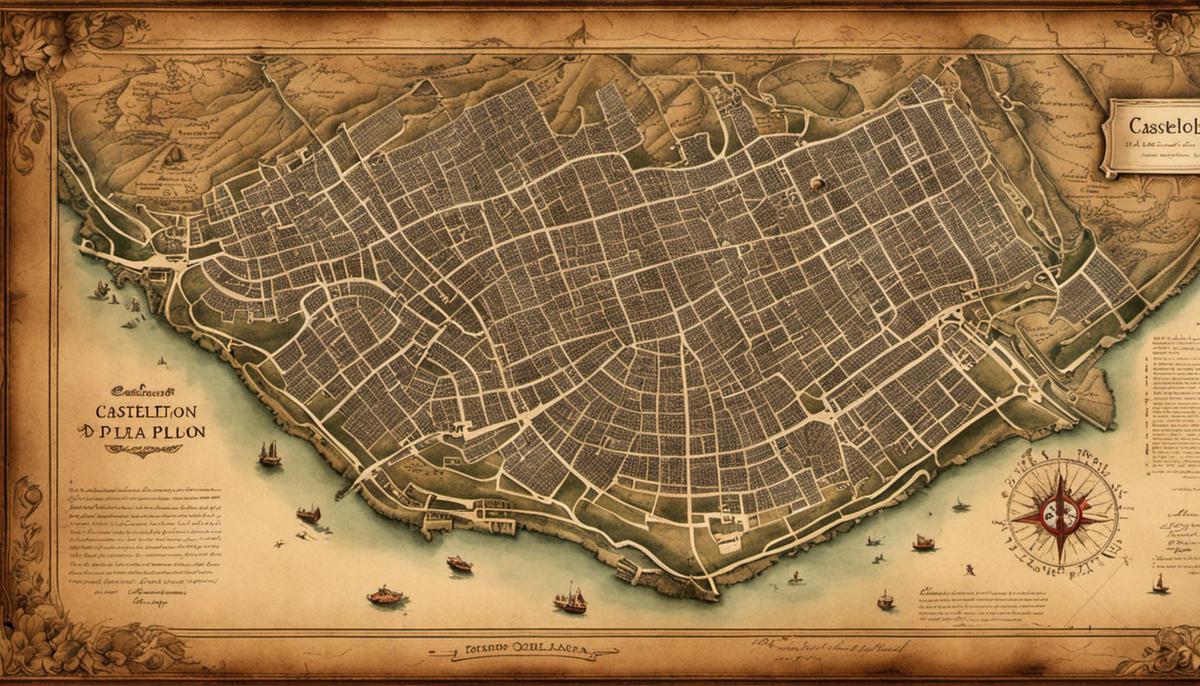Known for its rich past and diverse culture, Castellón de la Plana, a city fringed by the Mediterranean Sea, comes to life from each line of this written piece. Castellón de la Plana’s journey from its roots in antiquity to its position as a contemporary city offers an enthralling chronicle, filled with decisive epochs that have left their footprint on the city that we see today. A closer exploration of this city reveals an essential connection between its historical circumstances and the distinct artistic, culinary, and cultural traits that it boasts. As a popular tourist destination, the city equally intrigues and enchants its visitors, offering an eclectic range of sites to quench their wanderlust, unique local businesses to shop from, and a diverse gastronomy providing an authentic taste of Castellón de la Plana.
Historical Background of Castellón de la Plana
Historical background of Castellón de la Plana
Approximately one thousand years after Christ, Castellón de la Plana, often shortened to just Castellón, began to emerge as a distinguished settlement, sketched out at the fertile lowland of a Spanish coastal plain. The Arabs, who were the ruling power at the time, identified the area’s natural advantages and initiated the region’s first urban development. This planted the seed for the city’s existence and characterized Castellón as a significant player in the development of the region.
Founding and Strategic Importance of the City
Castellón was originally named Al-Balansiya by the Arabs, it was later changed to its present name following the Reconquista. During the 13th century, King James I of Aragon seized control of the territory from the Moors and subsequently granted a charter, instigating the formal founding of Castellón de la Plana in 1251. The city became a critical strategic foothold owing to its optimal location at the heart of the Costa del Azahar, near key transportation routes both along the coast and towards the interior.
Key Historical Events
Over the following centuries, Castellón had to endure and navigate several severe events like the Black Death in the 14th century and the War of the Spanish Succession in the early 18th century, which brought destruction and economic setbacks. Despite these adversities, it emerged admirably, showing resilience and adaptability. The city would also later play a role in the Spanish Civil War of the 20th century, with the port of Castellón being used as a base for the Republican navy.
Architectural and Cultural Influence
A testament to its vibrant past, Castellón de la Plana’s boundaries and influences are steeped in deep historic traditions. Defining features of this city include a rich cultural blend and an architectural fusion, showcasing a broad spectrum of Romanesque, Gothic, Baroque, and Modernist styles. These diverse influences paint a colorful historical tapestry, particularly apparent in the older parts of the city.
Most notable among the architectural landmarks are the El Fadrí bell tower, a stunning homage to Valencian Gothic architecture, and the modern Lonja del Cáñamo building, reflecting the city’s industrial progress. Further immersing itself in rich cultural connections, Castellón de la Plana is particularly renowned for its variety of festivals. The standout being the Magdalena Festival, a vivid depiction of the city’s historic migration from the mountains to the plains, serving as a spectacular display of the city’s diverse historical narratives.

Photo by johntorcasio on Unsplash
Cultural Insights of Castellón de la Plana
The Cultural and Traditional Fabric of Castellón de la Plana
Nestled in the heart of the Costa del Azahar along Spain’s eastern seaboard lies the enchanting city of Castellón de la Plana. Famous for its profound cultural traditions and historical richness, the city’s thriving art and cultural landscapes are nothing short of a testament to its distinctive charm and personality.
Castellón de la Plana’s Cultural Scene
Castellón de la Plana’s cultural scene is diverse and thriving, boasting a range of venues and institutions dedicated to the arts. The city’s cultural heartbeat, the Fine Arts Museum of Castellón, houses important archaeological pieces and a superb art collection featuring both traditional and avant-garde art. Castellón’s devotion to art is also apparent in its bustling theatre scene, inhabited by theatre companies like the Teatro Principal and the Espai d’Art Contemporani, that offer an array of performances from classical to contemporary.
Festivals and Traditions in Castellón de la Plana
In line with its deep-seated cultural heritage, Castellón de la Plana is famed for its year-round calendar of colorful and lively festivals and traditions. Chief among these is the city’s annual Magdalena festival. The festival, held every third Saturday in Lent, is a full week of parades, traditional dances, fireworks, and re-enactments, serving as both a spectacle of joy and a reflection of the city’s historical narrative. Other quintessential festivities include the St. John’s bonfires marked by parades and firework displays, and the invigorating Santa Clara festival blending religious respect with vibrant merriments.
Castellón de la Plana’s Gastronomic Richness
Castellón de la Plana’s gastronomy is an extravaganza of flavors, drawing largely on the region’s agricultural bounty and seafaring traditions. The city is synonymous with the quintessential Spanish dish, paella, locally often featuring rabbit or chicken, green beans, and even escargot. These, paired with locally grown oranges and regional wines, showcase the city’s culinary prowess. Seafood dishes such as suquet de peix, a hearty fish stew, and grilled sardines are also popular. The region’s artisanal cheeses and sweets like the turron (a nougat) and flao (a type of cheesecake) offer a delightful endnote to any meal.
Preservation of Traditions in Modern Society
While it embraces modernity, Castellón de la Plana steadfastly maintains a deep respect for its cultural heritage. This balance is beautifully displayed through its art and architecture, featuring a blend of abstract modernist designs next to gothic, baroque, and neoclassical structures. Residents continue to practice and pass on traditional arts and crafts techniques, including pottery and tile making. The local language, Valencian, continues to be spoken and preserved in daily life and schools, speaking volumes about Castellón’s commitment to maintaining its cultural identity against the backdrop of the globalized world.
In short, Castellón de la Plana is not just a modern city, but a place deeply rooted in its rich cultural heritage and traditions. These traditions are embodied in the city’s vibrant arts scene, its festive celebrations, its tasty gastronomy, and its strong commitment to maintain local customs and practices. Without a doubt, we can say that Castellón de la Plana is a city of substantial cultural vitality and intricacy.

Tourism in Castellón de la Plana
Discover Castellón de la Plana’s Historic Landmarks
Riddled with a wealth of architectonic gems, Castellón de la Plana invites you to explore its historic streets. At the heart of it all is the Plaza Mayor, the city’s iconic square, hosting three notable buildings: the City Hall, Santa María Cathedral, and the Fadri, a towering 58-meter high bell tower providing sweeping views of the city. Additionally, don’t miss out on El Grao, the city’s dynamic coastal area, teeming with a wide range of restaurants and a bustling lifestyle.
Pedestrian Areas and Parks
The center of Castellón de la Plana is characterized by numerous pedestrian-friendly areas, such as the Calle Mayor, offering a blend of historic charm and modern amenities. The city is also rich in green spaces; the Ribalta Park, a lush urban oasis featuring a statue of Francisco Ribalta, the city’s most famous painter, is a popular spot.
Museums in Castellón de la Plana
The city has a fascinating collection of museums. The Museum of Fine Arts, featuring an impressive collection of 13th- to 21st-century art, and the Ethnological Museum featuring a collection of traditional ceramics are must-visit sites. The Espai d’Art Contemporani, a museum which showcases contemporary art installations, should also not be missed.
Beaches around Castellón de la Plana
Castellón de la Plana has a wide range of beautiful Mediterranean beaches. The Gurugú beach, the Serradal beach, and the Pinar beach are all renowned for their golden sands, calm waters, and beachfront promenades with bars and restaurants.
Local Businesses and Shopping Opportunities
The city offers a variety of shopping opportunities, from traditional local markets such as the Mercado Central, where fresh produce and other local delights can be found, to modern shopping centers like Salera. The streets are lined with well-known chain stores and unique local boutiques offering a range of products.
Cuisine in Castellón de la Plana
The local gastronomy is also a highlight of Castellón de la Plana. Traditional Spanish dishes like paella, fideuá (a noodle-based variation of paella), and tombet (a vegetable dish) are delicacies that every visitor should taste. The city also has a strong tradition of winemaking, with many wineries available for tours and tastings.
Practical tips and Suggestions for Visitors
Being a city of flat terrain, getting around Castellón is easy either by foot, bike, or the city’s affordable tram system. The weather is typically Mediterranean; warm summers and mild winters, with rainfall being scarce. Bring a phrasebook or language translation app as English is not as commonly spoken as in other major Spanish cities. Lastly, enjoy the laid-back Spanish pace and soak up the city’s vibrant atmosphere.

The story of Castellón de la Plana, complete with its historical evolution, unique culture, and thriving tourism, provides an insightful lens to view this remarkable city. As we journey through its past, relive its magnificent cultural heritage and take in the spectrum of experiences it offers to tourists, we ultimately behold a city that harmoniously pairs historic traditions with dynamic modernity. Through its landmarks, culture, and gastronomy, Castellón de la Plana extends an open invitation to all to experience its charm, leaving lasting memories etched in the hearts of those who traverse its captivating and vibrant landscape.

